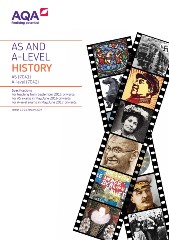2T The Crisis of Communism: The USSR and the Soviet Empire, 1953–2000 (A-level only)
This option provides for the study in depth of the practice and demise of Soviet Communism. It explores concepts such as de-Stalinisation, Glasnost, Perestroika and ‘people power’ and encourages students to reflect on issues of authority, leadership and legitimacy as well as the problems of communism in practice. Furthermore, this option will help students to understand issues surrounding Russia and Eastern Europe in the present day.
Part one: Crisis in the Soviet Union, 1953–2000
De-Stalinisation, 1953–1964
- The USSR in 1953: the Stalinist legacy; terror and paranoia; economic centralisation; the power vacuum and contenders: Malenkov, Beria, Molotov and Khrushchev; Khrushchev's success
- Khrushchev as leader: character; ideology and aims; style of leadership; political and legal reforms: the Secret Speech and de-Stalinisation within the USSR; changes to party organisation
- Economic and social developments: the reasons for and results of reform of industry and agriculture, including partial decentralisation and the virgin lands scheme; social conditions and living standards; the extent of the 'thaw' culturally
- Soviet foreign and international policies: split with China; peaceful coexistence with the West; the Cuban Missile Crisis; negotiations with the West over Berlin; the space programme
Years of Stagnation, 1964–1985
- Brezhnev as leader: reasons for Khrushchev's removal from power and Brezhnev's ascendancy; character, views and aims of Brezhnev and his associates in government; the nomenklatura system and corruption
- Economic and social policies and problems under Brezhnev: attempted reforms of Kosygin; the 10th Five Year Plan; agriculture; defence spending; consumer goods, living standards and life-styles for the elite and the workers
- Foreign and international policies: détente with the West; the invasion of Afghanistan and the impact on USSR; the Second Cold War
- Pressures for change and the reaction of the regime: political dissidents and protest, including Andrei Sakharov and Alexander Solzhenitsyn; the effect of the Helsinki accords; nationalist unrest; new leaders and political developments: Andropov; limited political and economic reform; Chernenko as leader and stagnation; the reformers and position of Gorbachev
The Gorbachev Revolution, 1985–2000
- Gorbachev as leader: personality, aims and power base; reasons for perestroika, glasnost and demokratizatsiya; withdrawal from Afghanistan and readiness to end the Cold War; summit meetings leading to the Malta Agreement
- Economic, political and social policies under Gorbachev: impact of Chernobyl; attempts at economic restructuring and the outcome; the attempt to democratise the Soviet political system and its outcome; main political reforms
- Revolution and counter-revolution in the USSR: opposition to Gorbachev's policies; nationalist unrest; deepening economic and political crises; the coup of August 1991 and Yeltsin's counter-attack; Gorbachev's resignation as president; the collapse of the USSR; reasons for Gorbachev's apparent failure
- Yeltsin as leader: personality and aims; style of rule; economic and political problems and policies; political unrest; re-election and resignation; Putin as leader; the state of Russia politically, economically and socially by 2000
Part two: Crisis in the Soviet Empire, 1953–2000 (A-level only)
Soviet Satellites, 1953–1968 (A-level only)
- The political and economic condition of the satellite states of central Europe: Poland and the leadership of Gomulka; Czechoslovakia and the leadership of Novotny; Hungary and the leadership of Nagy; Rakosi, Gero and Kadar; East Germany and the leadership of Ulbricht; the political organisation and influence of the Communist Party; economic organisation, state of collectivisation and the centrally planned economy; political and economic strengths and weaknesses of states
- Life in the Soviet satellite states: enforced Sovietisation; the use of propaganda; living standards; education; state organisations; benefits and problems
- Repression in the Soviet satellite states: state security; secret police systems; censorship; legal systems; the Church; emigration restrictions and defections
- Threats to stability in the Soviet satellite states: risings in East Germany, Poland and Hungary; issues over Berlin and the Berlin Wall; Dubcek and the Prague Spring in Czechoslovakia; reasons for the threats, their development and outcome for the state and for its relations with USSR
'Real existing Socialism', 1968–1980 (A-level only)
- Political developments in the satellite states of central Europe: Poland and the leadership of Gierek; Czechoslovakia and the leadership of Husak; Hungary and the leadership of Kadar; the GDR and the leadership of Honecker; policy changes and the extent of reform
- Economic and social developments in the Soviet satellite states: economic reforms; strengths and weaknesses; the influence of the West, economically and socially
- Challenges to Soviet control in the Soviet satellite states: Western influence and the media; the impact of the Helsinki accords; political activism including Charter 77 and KOR (Czechoslovakia); Church organisations (Poland and GDR); contested elections (Hungary)
- Strikes and demonstrations in Poland; the emergence of Solidarity in 1980 and the reaction of the Polish government and USSR
The Collapse of the Soviet Empire, 1980–2000 (A-level only)
- Political developments and activism within the satellite states before 1989: Jaruzelski and attempts to restrain Solidarity in Poland; pressure groups in Czechoslovakia and electoral contests in Hungary; regional peace workshops; the IFN and environmental groups in GDR
- The state of Communism in the satellite states of Romania and Bulgaria by 1989: leadership of Ceausescu in Romania and Zhivkov in Bulgaria; political and economic problems
- The collapse of Communism within the satellite states in 1989: reasons for and results of demonstrations and peaceful revolution in East Germany, Poland, Hungary, Czechoslovakia, Bulgaria and violent change in Romania
- The new national states of Eastern and Central Europe: political issues; problems of creating united and stable governments, including the separation of Czech and Slovak republics; the restoration of capitalism; closer ties with the West; political, economic and social progress and continuing difficulties by 2000
